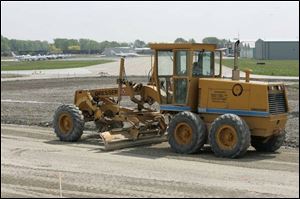
Metcalf Field repaving part of $4.56M modernization
5/22/2006
A runway at Metcalf Field in Wood County's Lake Township is graded prior to repaving.
Leveling the base for an airport runway may not seem to be a precision job, but even an inch makes a difference, especially with expensive oil driving up the price of asphalt paving mix.
"We gotta have it [level] within a half-inch," construction worker Andy Miller of Liberty Center said while spray-painting marks on the earth-stone bed for what will soon be the rebuilt crosswind runway at Metcalf Field in Lake Township in Wood County.
A dot in a circle means, for example, an extra half-inch is needed; a slash means the base is an inch too high, which would make the pavement too thin.
"Zeroes are good," Mr. Miller said as he and co-workers with Diversified Road & Pipe checked their work with strings, then summoned bulldozers and graders to make necessary adjustments.
Paul Toth, airport director for the Toledo-Lucas County Port Authority, said it's in Diversified's best interest to use exactly the right amount of asphalt because the Whitehouse-based contractor won't get paid more than the $1.31 million specified in its contract if the pavement ends up too thick.
Paving the new Runway 4-22 is scheduled for today or tomorrow, just a few days later than planned because of the recent persistent rain, Mr. Toth said.
But the work going on at Metcalf, which before 1955 was Toledo's primary airport, is more than just rebuilding a runway. Including that project, the port authority is spending $4.56 million to modernize the entire airport to improve safety and make Metcalf a stronger economic development generator, the airport director said.
"We actually have some good opportunities, with the improvements we're making, to draw some new aviation business out here," Mr. Toth said.
Eric Barnum, president of Crow Executive Air Inc., agreed that Metcalf, which to the general public exists deep in the shadow of Toledo Express Airport, is "a strategic asset to the city of Toledo" and is partly responsible for several recent business developments nearby.
"It is very strategically placed to serve the industrial areas that are concentrated south and east of Toledo," Mr. Barnum said.
About $4 million of the program is funded by the Federal Aviation Administration, and $291,000 is from an Ohio Department of Transportation aviation fund that Mr. Barnum said is supported entirely by aircraft registrations.
While most of the 100 or so aircraft based at Metcalf are private planes flown mainly for pleasure, there are at least a dozen corporate planes based there, said Mr. Barnum, whose firm sells aviation fuel and services and also flies charters, medical flights, and donated-organ transports.
Mr. Toth estimated Metcalf's flight activity at 60,000 "operations" - take-offs and landings - annually.
Rebuilding Runway 4-22, the "crosswind runway" at Metcalf, isn't a big problem this time of year because strong winds from the northeast or southwest are uncommon in the spring, he said.
Besides being rebuilt, the runway is being shifted, lengthened, and narrowed. The shift to the northwest provides more separation between it and its taxiway to meet current safety standards. An added 135 feet is a safety improvement to take advantage of available space, Mr. Toth said.
The narrowing, from 150 feet to 75, is appropriate because DC-3's no longer fly there, and the reduction is perfectly adequate for the private and corporate planes that do, he said.
The old concrete pavement, which dates to the runway's construction in 1939, has been pulverized and stored for use as a base material by Diversified.
Under a second $787,000 contract, the firm will replace the taxiway that feeds the southeast end of Metcalf's main Runway 14-32 with a new taxiway farther away - also for safety. Drainage work for that construction is under way.
A future port authority project will extend the new main taxiway so it parallels the main runway's entire length, Mr. Toth said. Planes using the northwest end of the main runway must now taxi on the runway to get to or from its end, a practice that increases accident risks.
A previous $850,000 project rehabilitated and extended the taxiway along Runway 4-22, also to eliminate taxiing.
Metcalf has no control tower, so pilots must rely on their observations and radio contact with other pilots to be sure the runway is clear for them to take off or land.
"The Federal Aviation Administration is focusing dollars on reducing runway occupancy time," Mr. Toth said.
Contact David Patch at: dpatch@theblade.com or 419-724-6094.